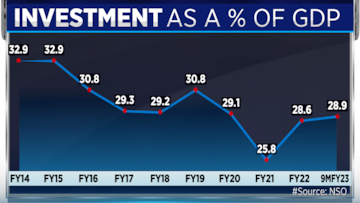The economic landscape is constantly evolving, influenced by various factors, including government policies, market conditions, and unforeseen events. In recent years, the investment patterns in many economies have experienced notable changes.
One significant trend in recent times has been the decline in corporate investment as a percentage of the Gross Domestic Product (GDP). Previously considered a key driver of economic growth, corporate investment has witnessed a substantial slip, falling to 14 percent of GDP.
This decline has raised concerns among economists and policymakers, as it indicates a potential slowdown in private sector activity and its impact on overall economic performance.
In an interview with CNBC-TV18, R Shankar Raman, whole-time director and CFO of L&T; Nikhil Gupta, chief economist at Motilal Oswal Financial Services and Hetal Gandhi, director of CRISIL discussed the current state of corporate investment and government capital expenditure (capex) and highlighted the shifts observed in these crucial sectors.
Raman said, "Some of the sectors where the investments are coming are commodity-related sectors, automobile-related sectors, construction equipment sector, hospitals, and energy transition. I think a lot of investments are happening either in adopting greener fuel or reducing the emissions of the current industries."
Meanwhile, talking about new age sectors, Gandhi said new sectors with a modern twist are emerging as a growing trend. To illustrate, there is a noticeable increase in capital expenditure not only in traditional industries like oil and gas but also in innovative areas such as green hydrogen.
Additionally, there are significant developments being announced in the electric vehicle industry and its associated ecosystem. We believe that the current growth in capital expenditure is a result of both a recovery in commodity markets and investments in these new-age sectors, he said.
In addition to the slip in corporate investment, state government capital expenditure (capex) has also experienced a decline. Capex refers to the funds allocated by governments for the development and maintenance of infrastructure, public projects, and other essential sectors.
However, recent data indicates a downward trend in state government capex, signaling a reduced focus on infrastructural development and public welfare initiatives. This decline could have repercussions on the long-term growth prospects of various regions.
However, talking about corporate growth, Gupta said we are witnessing significant growth, exceeding 20 percent, in certain regions. However, what truly holds significance is the level of investment, whether it is from corporations or in total as a percentage of GDP.
This is crucial due to the maximum base effect observed in FY20 and FY21, which resulted in a decline in various indicators due to the impact of COVID. Additionally, there has been a build-up of demand within the system over the past few years, contributing to the improved growth we are currently experiencing.
While state government capex has witnessed a decline, the overall government capex in the country has shown mixed results. In the fiscal year 2023, government capex has picked up, reaching 7.7 percent of GDP, compared to the pre-COVID level of 5 percent.
For more details, watch the accompanying video






